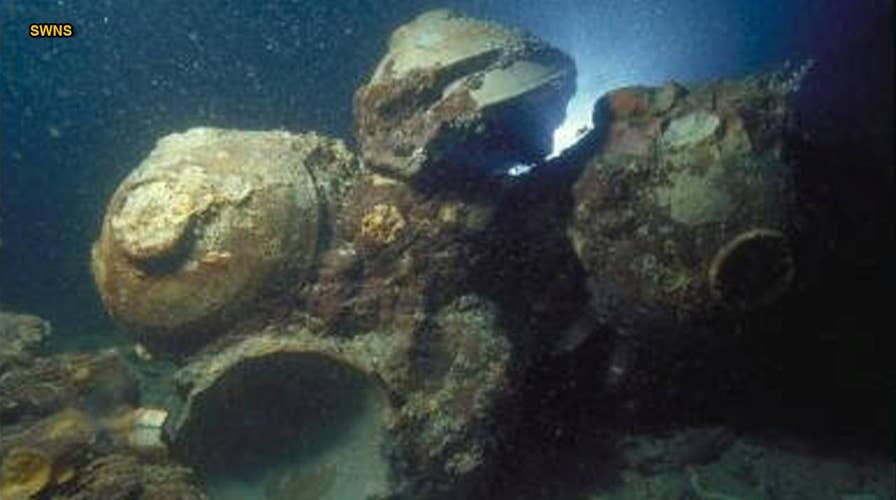800-year-old 'Made in China' label reveals shipwreck secrets
An 800-year-old piece of pottery has helped archaeologists put together fascinating new details about a medieval ship that sank off the coast of Indonesia.
An 800-year-old piece of pottery has helped archaeologists put together fascinating new details about a medieval ship that sank off the coast of Indonesia.
The wooden hull of the ship, which sank in the Java Sea, has long since disintegrated, but its cargo offers vital clues about the vessel.
Fishermen discovered the wreck site in the 1980s and archaeologists have spent decades analyzing objects found on the seabed. Salvage company Pacific Sea Resources recovered the artifacts in the 1990s and donated them to Chicago’s Field Museum.
EXPERTS DISCOVER 'CHRISTOPHER COLUMBUS' ANCHOR AT CARIBBEAN SHIPWRECK SITE
The ship, which was transporting ceramics and luxury goods, is now revealing its secrets thanks to new analysis of the cargo. Experts published their findings in the Journal of Archaeological Science: Reports.

An inscribed piece of pottery recovered from the shipwreck site (© The Field Museum / SWNS.com)
“Initial investigations in the 1990s dated the shipwreck to the mid- to late 13th century, but we’ve found evidence that it’s probably a century older than that,” said Lisa Niziolek, an archaeologist at the Field Museum in Chicago and the study’s lead author, in a statement. “Eight hundred years ago, someone put a label on these ceramics that essentially says ‘Made in China’ — because of the particular place mentioned, we’re able to date this shipwreck better.”
The ship’s cargo included ceramics marked with an inscription that may indicate they are from Jianning Fu, a district in China. Experts, however, note that after Mongol invasion of China around 1278, the area was reclassified as Jianning Lu.
“The slight change in the name tipped Niziolek and her colleagues off that the shipwreck may have occurred earlier than the late 1200s, as early as 1162,” they said, in the statement.
WILL CANNONBALL DISCOVERY LEAD TO LOST GALLEON'S SUNKEN 'TREASURE'?
The likelihood of a ship from the Jianning Lu era carrying old pottery is slim, according to Niziolek. “There were probably about 100,000 pieces of ceramics onboard. It seems unlikely a merchant would have paid to store those for long prior to shipment — they were probably made not long before the ship sank,” she explained.
In addition to ceramics, the ship was also carrying elephant tusks, possibly for use in medicine or art. Sweet-smelling resin, which could have been used for incense or for caulking ships, was also found.
Previous carbon dating of the tusks and resin had dated the wreck to between 700 and 750 years ago. However, improved carbon dating techniques tell a different story.
PIRATE MYSTERY: DOES THIS 300-YEAR-OLD BONE BELONG TO 'BLACK SAM' BELLAMY?
"When we got the results back and learned that the resin and tusk samples were older than previously thought, we were excited,” said Niziolek. “We had suspected that based on inscriptions on the ceramics and conversations with colleagues in China and Japan, and it was great to have all these different types of data coming together to support it.”
Dating the shipwreck to 800, rather than 700 years ago is significant, according to the archaeologist. “This was a time when Chinese merchants became more active in maritime trade, more reliant upon oversea routes than on the overland Silk Road,” she said. “The shipwreck occurred at a time of important transition.”
Shipwreck sites offer a fascinating glimpse into the past. Last year, for example, experts announced the discovery of a centuries-old anchor in the Caribbean believed to be from one of Christopher Columbus’ ships.
MYSTERIOUS SHIPWRECK DISCOVERED IN GREAT LAKES BELIEVED TO BE NEARLY 200 YEARS OLD
Also in 2017, archaeologists in Japan found a cannonball that could lead to the sunken remains of a treasure-laden Spanish galleon.
In 2016 archaeologists said that they had discovered the 500-year-old wreckage of Portuguese ship off Oman. The ship, Esmeralda, was piloted by an uncle of explorer Vasco da Gama.
The Associated Press contributed to this article.
Follow James Rogers on Twitter @jamesjrogers
